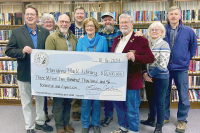Alternative school gets $1.4 million to offer comprehensive help to struggling youth
 Tucked away on the corner of Kentucky and Virginia avenues in the old Hazelwood Elementary School building, the Alternative Learning Center in Waynesville doesn’t look much like a high school. It’s got just four classrooms, and a stroll through the hall during school hours doesn’t reveal the usual scene of a teacher standing in front of orderly rows of desks. In fact, though about 200 students are enrolled at any one time, only 40 or 50 show up each day.
Tucked away on the corner of Kentucky and Virginia avenues in the old Hazelwood Elementary School building, the Alternative Learning Center in Waynesville doesn’t look much like a high school. It’s got just four classrooms, and a stroll through the hall during school hours doesn’t reveal the usual scene of a teacher standing in front of orderly rows of desks. In fact, though about 200 students are enrolled at any one time, only 40 or 50 show up each day.
“Lots of students are facing obstacles with their family life, or they may need to support their children, or they may be pregnant or have children,” said Caroline Williamson, ALC’s program coordinator. “We meet students’ needs where they are in their journey.”
The ALC is a place for students to go for their high school education when, for whatever reason, the traditional set-up just isn’t working for them. Though afternoon activities get creative with some interdisciplinary project-based learning, the school relies on an online platform for its core subjects. That allows students to work from home instead of coming to the school building every day. Students might take just one class at a time or a full load, depending on what else is going on in their lives.
“[If] a kid walks in and he’s working 70 hours because he’s self-supporting, we need to make a way for that kid to keep his 70-hour job and pay his bills, but at the same time do his studies,” explained Kyle Ledford, ALC director.
It can be a hard job for the ALC staff. They’re working with kids with varied backgrounds and life situations, trying to teach a high school curriculum while at the same time guiding them toward a successful post-high school future.
Related Items
A million-dollar idea
A $1.4 million federal grant the ALC recently landed could make that easier. The 21st Century Community Learning Centers Grant, to be disbursed over four years, will allow the school to almost double its teaching staff, expand its academic programming, offer classes year-round and provide support for parents and high school grads working toward a next step. The school’s vision is to become a hub of resources and help for people who just need a leg up to become self-sufficient.
“When I was young, school was the center of the community,” Ledford said. “Now it’s not, for whatever reason. We’re going to try to be more in the center of the community. We’re going to try to be a place where people in the community look to for help to do whatever it is they want to do.”
The ALC is already pretty community-oriented, but they’re limited in what they can do. Pinpointing the specific needs of each of 200 teenagers with a staff of four teachers is just plain impossible. Using the grant money, the ALC will nearly double its teaching staff to hire three new fulltime teachers. In the meantime, administrators will look for new grants to take over when this one dries up. With the programs in place, doing so should be an easier task than starting from scratch.
“If you’re not doing the job, you don’t get the money,” Ledford explained. “We’ve been the youth contractor for 30 years because we’ve always done the job. Most of these funding streams are based on performance so if you perform you have the ability to do it again.”
Getting to the root
The job that Ledford envisions the ALC doing is a four-pronged approach to success that would begin before students even enter high school. The plans include a 20-day transition program for rising high school freshman who are considered to be at risk of dropping out. The program will teach organizational skills needed to do well at school, as well as practical lessons such as how much it costs to own a car or a home. Students will also create a 10-year plan to start thinking about what might come after high school.
The hope is that this kind of preparation would give the students the boost they need to start high school out on the right foot and, eventually, earn their diploma.
“That’s where all the research tells you [that] you lose kids the most,” Ledford said. “That transition is so difficult. That’s where we feel we’ll make the most headway.”
Once the grant-funded programs go into effect, regular school hours will continue as normal, 8:30 a.m. to 2 p.m. every weekday. ALC teachers are now getting training in 21st Century Learning techniques, which will make the classroom a more active place.
And after 2 p.m. the ALC will start offering a diversity of programs aimed at bridging all those gaps that traditional school can’t address.
“Why does a kid not attend [school]? That’s what we’re going to do. We’re going to get to the root cause,” Ledford said.
Students will be able to get academic tutoring before normal school hours, and from 3:30 to 5:30 p.m., those looking for a challenge will have a chance to take Advanced Placement classes. These are high school courses designed to teach to a college level. If students pass a standardized test given at the end of the year, they earn college credit.
“That’s something that’s not readily available during the school day,” Ledford said. “Schools have to make special schedules for those types of things.”
Programming will continue through 7 or 7:30 p.m., with offerings looking beyond the immediate requirements of high school curriculum. Students will be able to take classes in healthy cooking and eating, learn parenting skills, get pre-apprenticeship training and get help with the transition from high school to community college.
Guiding the transition
Ledford and Williamson think the apprenticeship and transition help will become hugely important.
“This is going to help us add things after graduation day that will allow us to help these kids longer and, I think, do our job better, because we’re going to be able to see it through,” Ledford said.
Even now, the folks at the ALC find themselves getting plenty of calls from former students who need help. Some call because a friend or relative they were living with dies or moves away, Williamson said, and “others call when they become pregnant or need a job. I’ve gotten lots of contacts recently — ‘I need a job. Do you have any openings?’”
Then, Williamson will find herself reeling off a list of local businesses where the young adult on the other end of the line might have some more luck.
Other students just need help seeing the steps between them and their final goal. They might not know how to fill out a FASFA form, how to go about applying to college or how to look for scholarship money. Or, they might not have the most thought-through career plan to begin with.
“A kid walks in and you say, ‘What do you want to do when you grow up?’ and he says, ‘I want to be a marine biologist.’ ‘Where do you live? On Crabtree [Road]? Do you want to move to a big city?’ ‘No, I want to stay right here,’” Ledford said, reciting a version of a conversation he’s had many times. “Either you haven’t thought about what a marine biologist is or you think the ocean is coming to Crabtree.”
The family picture
Sometimes, the parents of ALC students also have those same struggles. They need more training to get ahead in their job, or they don’t have a handle on how to prepare healthy meals without breaking the bank, or they need to brush up on their reading and basic math skills.
The new programs will be aimed at parents, too.
“You’ve got endless volumes of research that talk about education being the springboard by which upward mobility is built on,” Ledford said. “We feel like by offering students and parents we’re going to get the parents involved, by which the students will then be more involved.”
Ledford cited research indicating that those kinds of interventions save hundreds of thousands of dollars per year, because they keep the government from having to pay for social services and incarceration.
The same goes for the students.
“Five hundred thousand dollars apiece is what North Carolina has to spend on these kids should they not get a diploma,” Ledford said.
The school has already graduated 428 students since it opened in 2007, students who otherwise would have dropped out. With the grant money, Ledford and Williamson are hoping the impacts — social and economic — will multiply.
The plan is to spend the next month or so nailing down the specifics and start rolling it out in November or December. By January, Ledford said, the new and improved ALC should be in full swing.
“The whole picture of this grant, I guess,” Williamson said, “would be that I hope our students and their families become sustainable.”
Become a mentor
The Alternative Learning Center is looking for people willing to mentor its students. Mentors and mentees can meet as often or as little as the pair agrees on, but the goal is to give students a role model to lean on when navigating their own maze of life decisions. To apply, contact Caroline Williamson at 828.454.6590, ext. 106.









